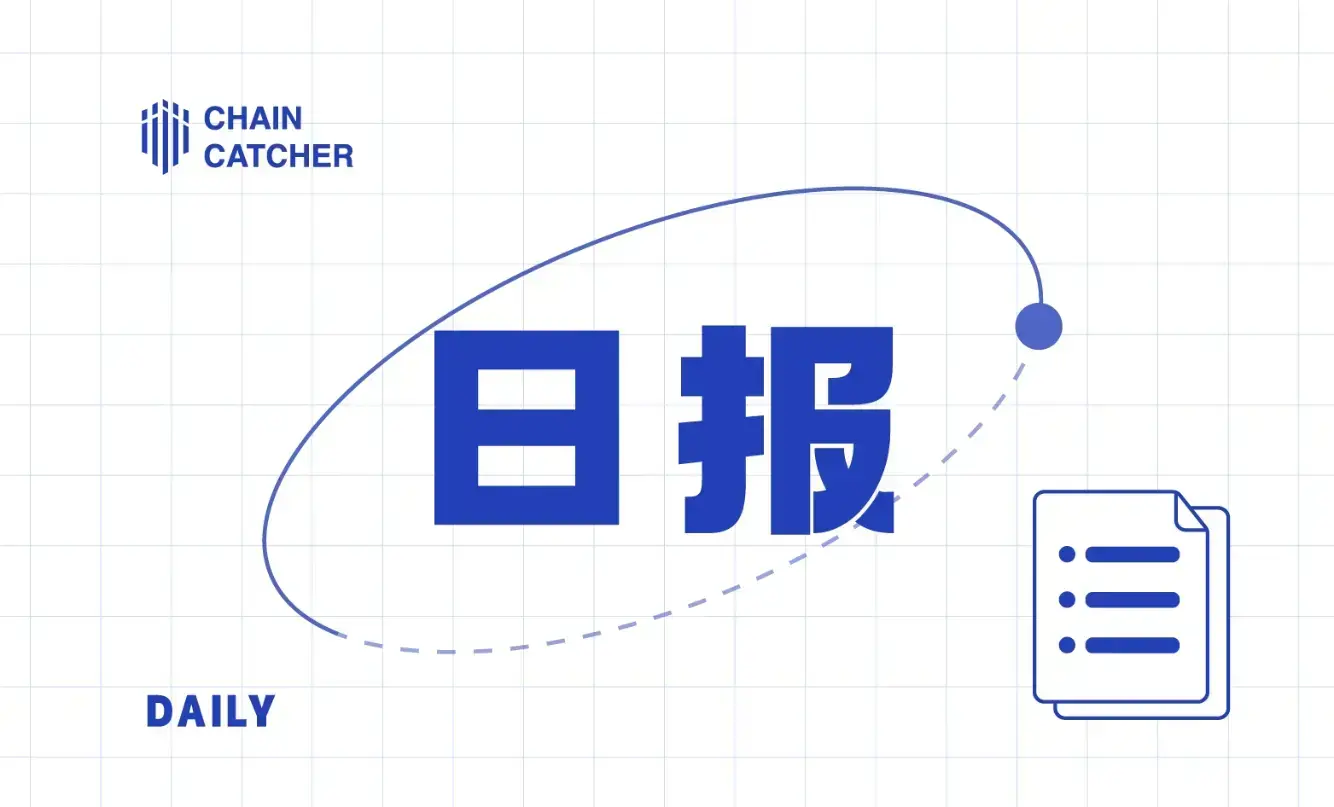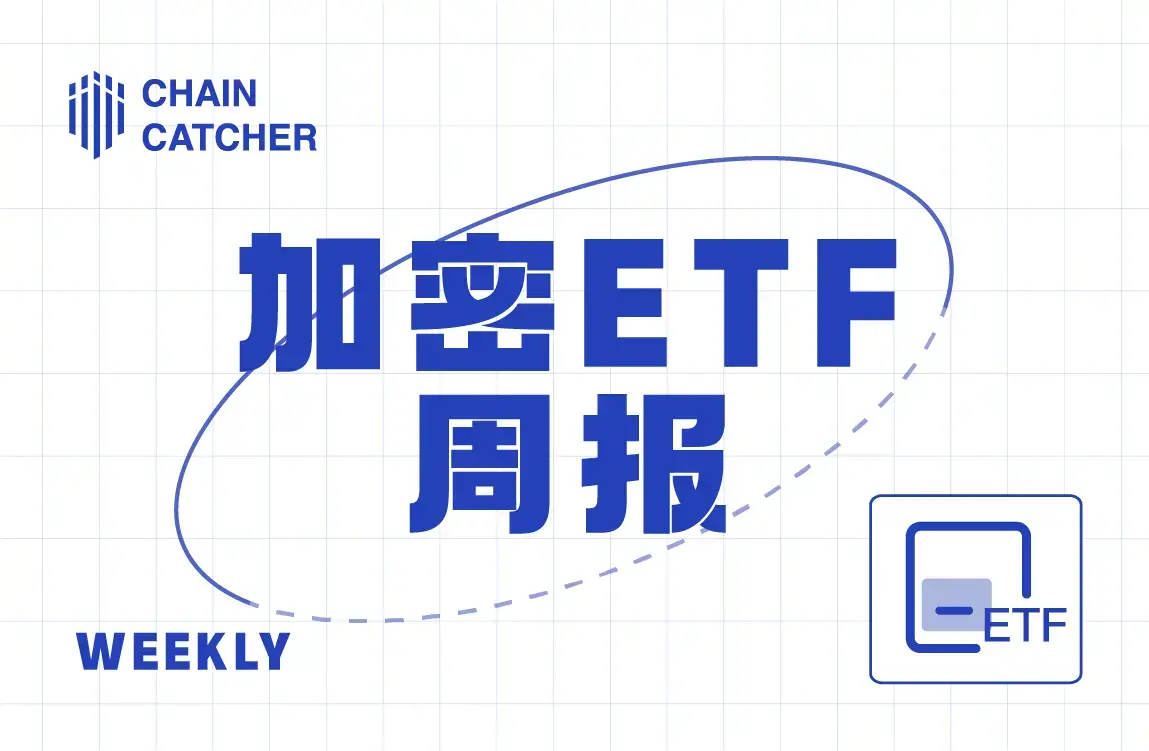Fined over $4.3 billion, Zhao Changpeng forced to "resign," has Binance's bad news been fully priced in?
Author: Xiyou, ChainCatcher
The criminal investigation by the U.S. Department of Justice into Binance, which began in 2018, has finally come to a conclusion after five long years. On November 21, both parties reached a final settlement with a staggering $4.3 billion fine.
On that day, ChainCatcher reported that the U.S. Department of Justice announced that Binance and its CEO Changpeng Zhao had accepted criminal and civil charges against them, and both parties had reached a settlement agreement regarding the misconduct related to the criminal charges. Binance admitted to participating in anti-money laundering violations, unauthorized fund transfers, and sanctions violations, and agreed to plead guilty to willfully violating the Bank Secrecy Act and the International Emergency Economic Powers Act. Meanwhile, Changpeng Zhao also stated that he was guilty of criminal charges related to anti-money laundering and violations of U.S. sanctions, including allowing transactions with Iran and terrorist organizations like Hamas, and he resigned as CEO of Binance.
Regarding the aforementioned illegal activities, Binance pleaded guilty and agreed to pay a total of over $4.3 billion in fines to settle, which also includes the amount agreed upon with the U.S. Commodity Futures Trading Commission (CFTC) for civil settlement. This also means that the U.S. Department of Justice has temporarily concluded its criminal charges against Binance with the hefty fine of $4.3 billion.
Many believe that the U.S. Department of Justice's criminal investigation into Binance, which has hung over the company like the Sword of Damocles for years, has finally come to rest. Although the $4.3 billion fine is expensive, as long as it does not affect normal operations, it is merely a drop in the bucket for the Binance platform, and it can be considered that the bad news has been fully priced in.
However, it is important to note that the settlement agreement with the U.S. Department of Justice does not include the lawsuit disputes with the U.S. Securities and Exchange Commission (SEC). In June of this year, the SEC also sued Binance and Changpeng Zhao, claiming they violated U.S. investor protection laws. Currently, there has been no clear conclusion regarding the SEC's charges.
On November 22, Binance announced that it had reached a settlement with the U.S. Department of Justice, the Commodity Futures Trading Commission (CFTC), the Office of Foreign Assets Control (OFAC), and the Financial Crimes Enforcement Network (FinCEN) regarding historical registration, compliance, and sanctions issues. The plan acknowledges that the company had past violations but does not accuse it of misappropriating any user funds or engaging in market manipulation, which opens a new chapter for the company.
So, is the conclusion of the U.S. Department of Justice's charges against Binance a positive development? How will the hefty $4.3 billion fine be paid, and where will the funds come from? Will Binance follow in the footsteps of BitMEX? What impact will this settlement agreement have on Binance and the cryptocurrency industry?
Over $4.3 Billion Fine, Changpeng Zhao "Forced" to Resign
According to information disclosed in court documents, the U.S. Department of Justice's settlement agreement with Binance mainly consists of three parts: fines, penalties against CEO Changpeng Zhao, and compliance requirements for the platform.
First, regarding the fines, Binance has been fined a total of $4.316 billion, setting a record for fines in U.S. financial compliance history. The fine can be divided into two main parts: one part is the criminal fine, which has been reduced by 20% due to Binance's cooperation, bringing the amount to $1.805 billion, to be paid within 15 months; the other part is the forfeited funds from illegal operations, approximately $2.51 billion. This amount mainly consists of two parts: the first part is a fine of $1.612 billion for illegally providing services to U.S. users, to be paid within six months after the Binance ruling; the second part is $898 million earned from providing illegal services to individuals related to Iran, which must be paid within 30 days.
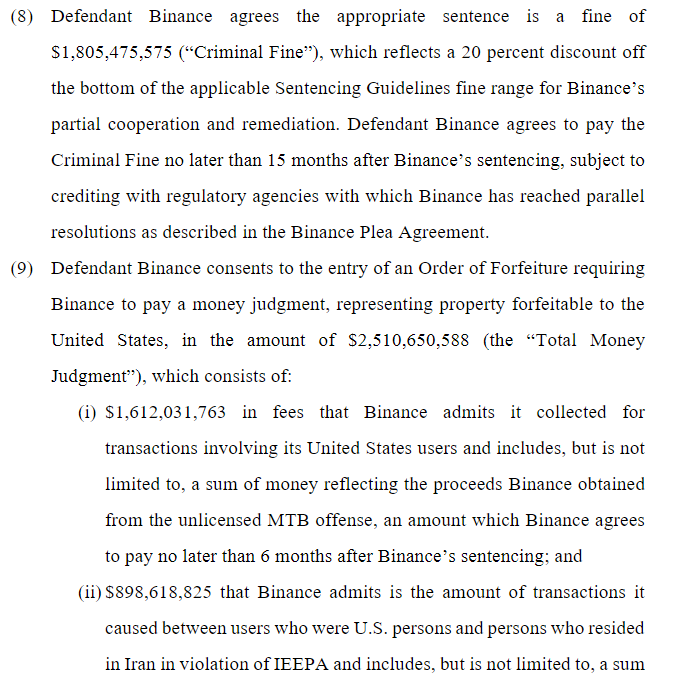
Next is the penalty against CEO Changpeng Zhao, who is the soul of Binance, and the U.S. Department of Justice's ruling on him has also attracted much attention. According to documents from the U.S. District Court in Seattle, Zhao had already signed a related guilty plea confidentiality agreement with U.S. government agencies on November 14, agreeing to pay a fine of $50 million and also agreeing not to have any third parties, such as lawyers, speak on his behalf.
Additionally, Zhao faces the possibility of imprisonment. According to federal sentencing guidelines, Zhao faces a maximum of 10 years in prison, but the latest agreement indicates he will face a maximum of 18 months and a minimum of 10-12 months in prison. The U.S. Department of Justice has not yet decided how long his imprisonment will be. CoinDesk reported that Zhao has been released after posting $175 million in personal bail, with a sentencing hearing scheduled for February 23, 2024, Pacific Time.
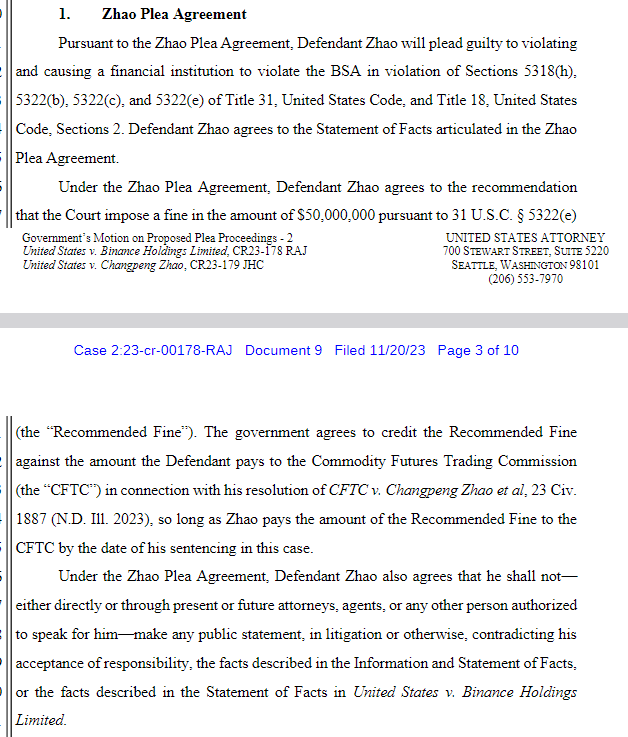
The agreement also prohibits Zhao from participating in the operation or management of Binance's business for the next three years, with the ban taking effect from the date of his guilty plea. Early this morning, Zhao announced that he had resigned as CEO of Binance, a position he held for six and a half years, with Richard Teng, former Global Regional Market Director of Binance, taking over as CEO.
Finally, the agreement also includes compliance requirements for the Binance platform, requiring Binance to fully exit the U.S. market and appoint an independent compliance monitor to oversee, correct, and enhance the exchange's anti-money laundering and sanctions compliance program, ensuring adherence to the terms of the guilty plea agreement. During this period, the U.S. Treasury Department will have access to Binance's records and systems. After the deadline, Binance's CEO and compliance officer will certify that Binance has fulfilled its disclosure obligations and compliance commitments under the guilty plea agreement.
In summary, Binance not only needs to pay a fine of $4.316 billion to the U.S. government but also needs to undergo compliance rectification. CEO Changpeng Zhao not only has to pay a fine of $50 million but is also forced to stop participating in Binance's related business and will face sentencing.
Since the news of Binance's settlement with the U.S. Department of Justice broke yesterday, the price of BNB has experienced significant fluctuations, with a volatility of over 24% within 24 hours.
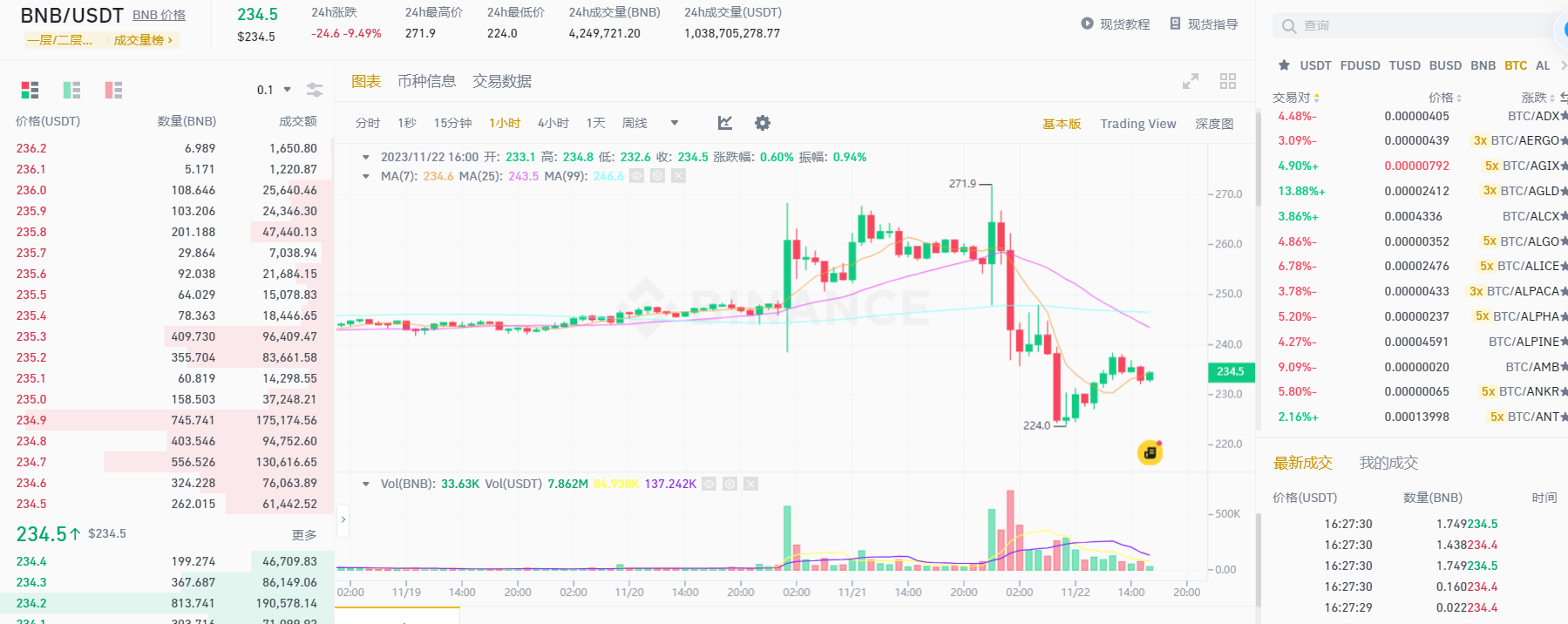
After the news of the settlement on November 21, the price of BNB surged from $240 to $271 within an hour. Following the announcement of Zhao's resignation as CEO and the specifics of the settlement agreement early on the 22nd, the price of BNB plummeted from $271 to $224, with the current quote at $234. In contrast, the price of BTC during the same period fluctuated only by 2.5%.
Will the $4.3 Billion Fine Affect Binance?
As the largest cryptocurrency exchange in the world, controlling over 50% of the assets in the crypto market, Binance's financial security is crucial for every user in the crypto industry. For users, the current concern is how Binance will operate after going through these challenges, including how it will pay the hefty $4.3 billion fine imposed by the U.S. Department of Justice. Will it affect the safety of user funds? Can Binance withstand the $4.3 billion fine and the resignation of its founder, CZ?
It is reported that even the federal prosecutors investigating this case are worried that the lawsuit could lead to panic among Binance users, causing them to withdraw funds collectively, resulting in a liquidity crisis for the platform, reminiscent of the FTX incident.
How long will it take for Binance to earn back $4 billion? Some crypto users have stated that even in the current bear market, $4 billion is roughly Binance's annual revenue during a bear market.
In a tweet, they wrote: If we take Coinbase's Q3 financial report as a reference, its Q3 trading volume was $76 billion, with trading revenue of $288.6 million, and its market share was about 5%-7%. Binance's market share in spot trading is about 7-10 times that of Coinbase, so Binance's quarterly revenue in spot trading could be around $2 billion to $2.88 billion. However, due to Binance's lower profitability efficiency compared to Coinbase, including rebates, it can earn about $500 million each quarter, resulting in an annual revenue of over $2 billion. Additionally, Binance also has a futures market, with Q3 futures trading volume reaching an industry "low point": a total of $6.1 trillion, with Binance's market share around 50%, approximately $3.1 trillion, which could earn at least $600 million, totaling $2.4 billion annually.
From this perspective, Binance's annual revenue from trading alone could exceed $4 billion, not accounting for its mining pool, Binance investment institutions, BnBChain, and other businesses. Furthermore, in a bull market, the trading volume and profitability of exchanges often increase tenfold or more.
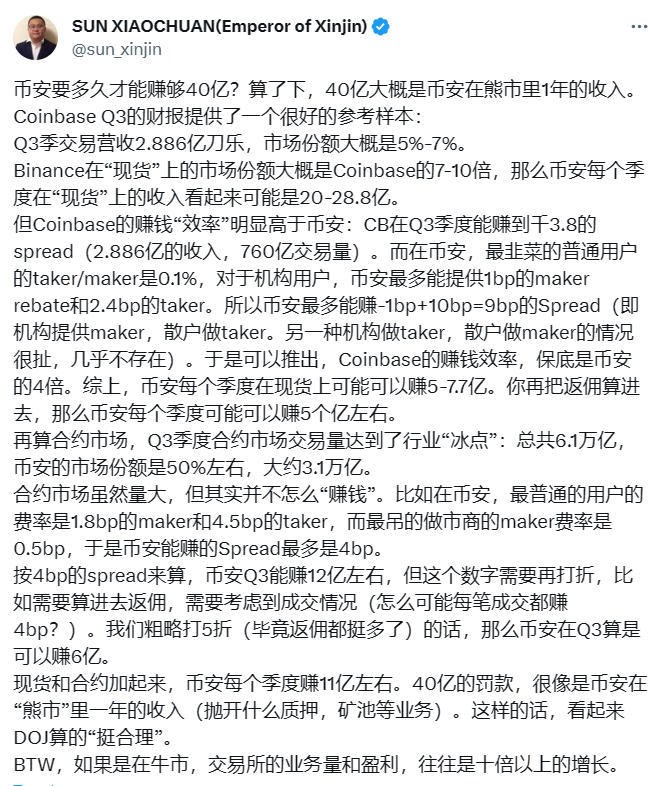
However, some users are skeptical about the validity of the above data estimates, stating that the authenticity of the calculated data is worth verifying, and the credibility of the annual revenue data related to Binance's trading business seems somewhat tenuous. Although these estimated figures need further validation, they still provide users with a reference dimension for evaluation.
Moreover, from the perspective of the platform's capital outflow, the current impact of this event remains within a controllable range for the platform. According to Nansen data, since the news broke, only $1 billion has flowed out of the Binance platform. However, according to Binance's latest proof of reserves report, the exchange currently holds approximately $65 billion in crypto assets. Of course, this is not the first time Binance has dealt with large-scale capital outflow issues; during the FTX collapse, the daily withdrawal volume also exceeded $1 billion. On the other hand, this also suggests that, at least for now, the Binance platform is healthy.
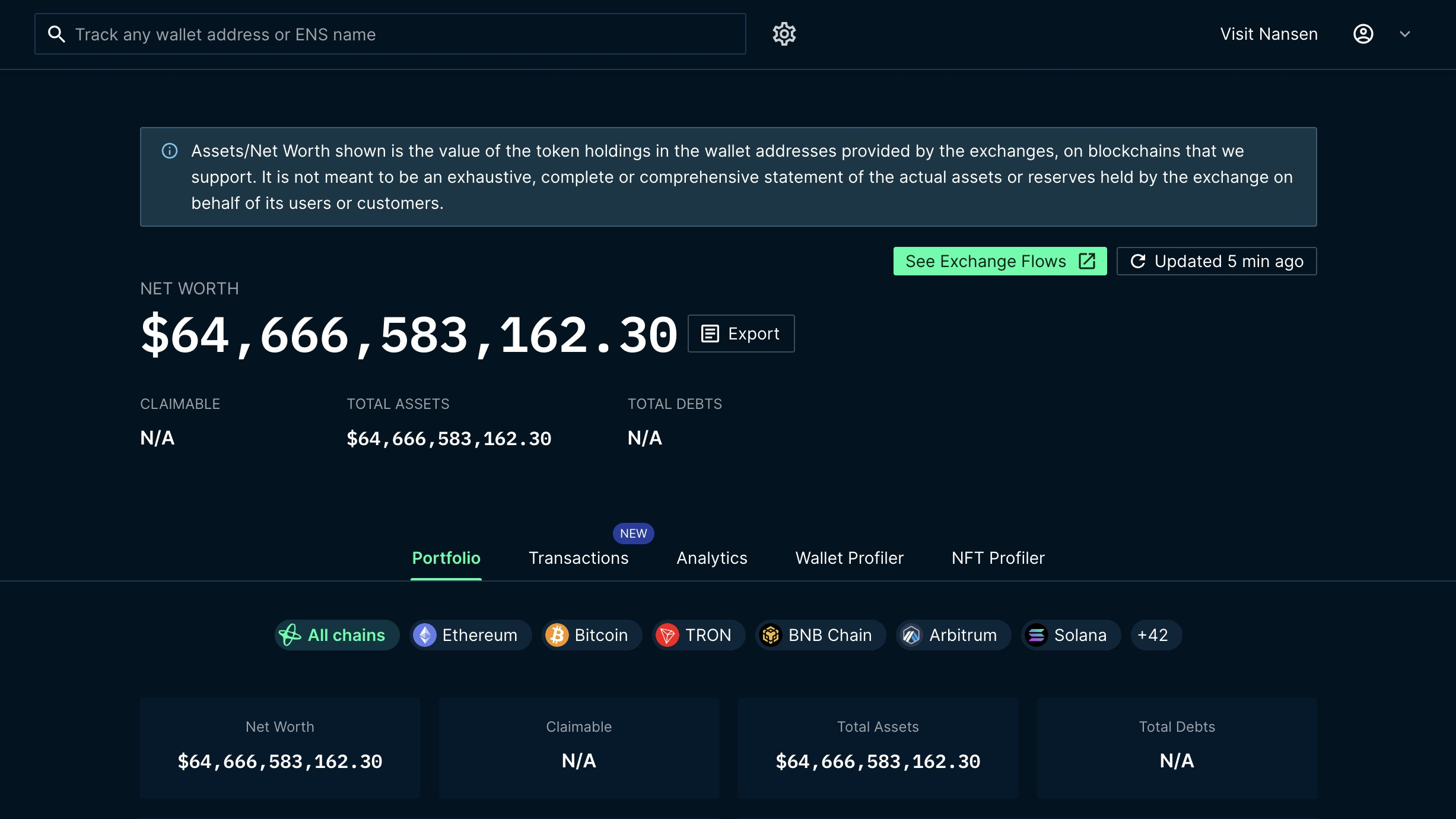
On the afternoon of November 22, Coinbase executive Conor Grogan stated on social media X that Binance is very likely to fully pay the $4.3 billion fine without selling any crypto assets.
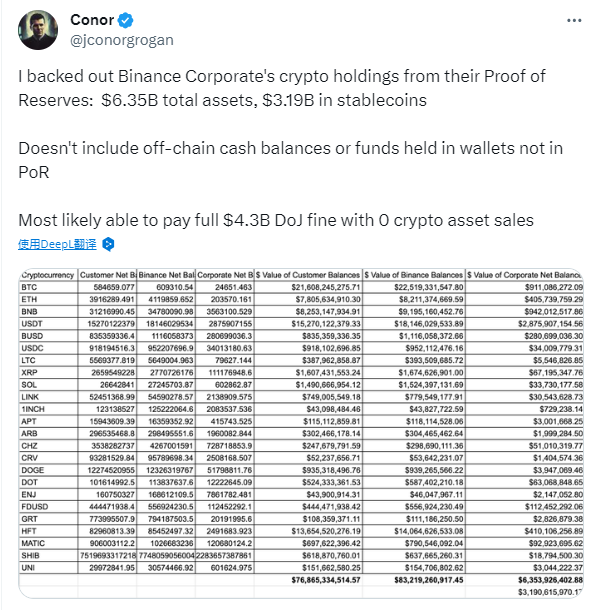
In summary, although there is no clear explanation yet on how Binance will pay this hefty fine, the current operational data from the platform indicates that it has not significantly impacted its trading business.
Is the Conclusion of the Binance Fine a Positive or Negative Development?
Currently, many industry participants believe that the U.S. Department of Justice reaching a settlement with Binance on the charges is of great significance for the crypto industry, as it will promote the compliance process in the crypto sector. For Binance, ending the years-long criminal investigation that has loomed over the exchange like the Sword of Damocles, and only needing to pay compensation and comply with regulatory agreements may open a new chapter for the company.
However, many users are concerned that the SEC has not yet made a final statement on its lawsuit against Binance, indicating that the negative news may not be fully priced in, and Binance may still face another hefty fine from the SEC.
Regarding the SEC's subsequent regulatory discussions, Binance co-founder He Yi responded in the community that the SEC is a civil lawsuit, and it will take time to resolve, similar to Ripple. She also added that their early compliance was not good enough, and mistakes must be addressed. Binance did not touch user funds or manipulate the market, and if compliance is done well, they will be good actors. This is not just targeted at Binance; first it was BitMEX, now it's Binance, and they are all in line. Now it is compliant Binance, and a new chapter is opening.
Regarding the significance of the Binance settlement for the crypto industry, Coinbase CEO stated that the settlement will open a new chapter for the industry, and the crypto sector should establish itself in the U.S. in a compliant manner. Due to the lack of regulatory transparency, we have faced many difficulties in the U.S., and I hope today's news can serve as a catalyst for achieving the goal of regulatory transparency.
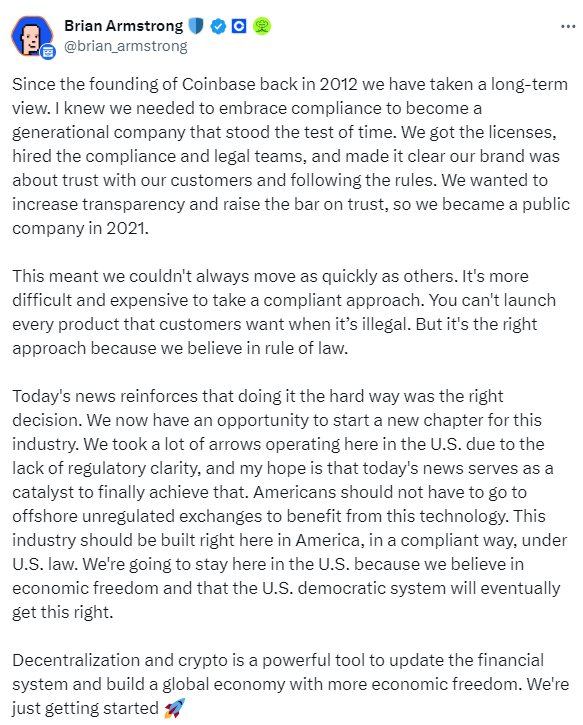
Matrixport stated that U.S. agencies did not accuse Binance of misappropriating any user funds or engaging in market manipulation, and the fine amount is lower than the previously feared $10 billion. Binance is likely to remain one of the top three exchanges in the next 2-3 years. Although this guilty plea agreement does not include the U.S. SEC, it is a very favorable outcome for Changpeng Zhao and Binance itself.
Regarding the impact of this regulation, he wrote that more exchanges will strengthen their compliance programs, which will help in the approval of spot Bitcoin ETFs in the U.S. With this guilty plea agreement, expectations for spot Bitcoin ETFs may have risen to 100%, as the entire industry will be forced to comply with the rules that traditional financial companies must follow. More importantly, this industry's legitimization will strengthen institutional investors' cases for adopting Bitcoin and may make Bitcoin a safe-haven asset in investors' portfolios. Changpeng Zhao may return during the next bear market in 2026.
Crypto KOL Shen Yu also stated that the settlement regulatory agreement between the U.S. Department of Justice and Binance paves the way for ETFs.
However, for Binance, the long-term impact of this event will take more time to gradually clarify, including whether it can obtain compliance licenses in the U.S., whether the new CEO can gain the team's recognition and cohesion, and other issues that will determine Binance's long-term fate.
